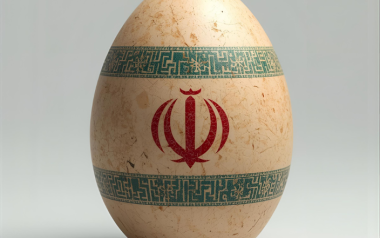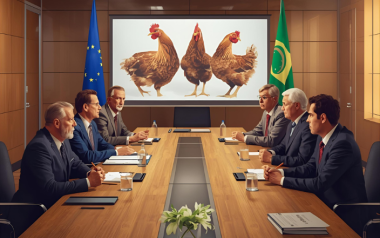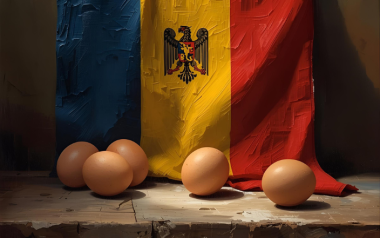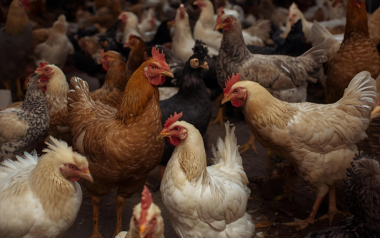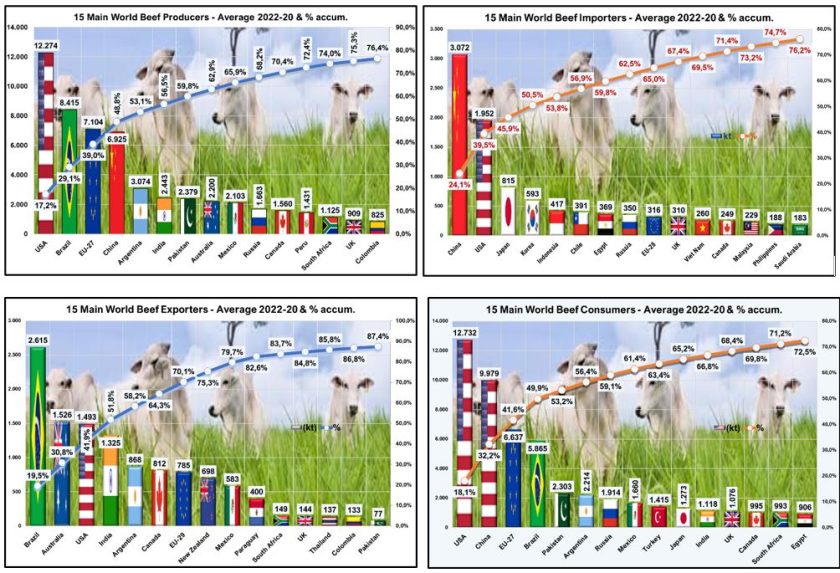
02 Jul 2024
The “Glocal Company”: an update for the animal protein sector
The production of animal protein continues to grow over the years, hand in hand with the expansion of large companies in the meat sector, but how to become a "glocal" company worldwide. These companies supply beef, poultry and pork, with poultry leading the market.
The production of animal protein continues to grow over the years, hand in hand with the expansion of large companies in the meat sector, but how to become a “glocal” company worldwide. These companies supply beef, poultry and pork, with poultry leading the market.
In this regard, the author in 2011 wrote the article “The Glocal Company”, as at that time Brazilian groups in the animal protein sector were expanding their operations to several countries around the world.
- This movement was led by companies in the beef sector that, while establishing operations in the main world meat centers, diversified their business activities to include poultry and swine.
The logic of being present in all major meats is easy to understand by examining data from 1965 to 2020, where it can be seen that beef is surpassed in production by pork between 1975-80 and by poultry between 1990-95 (Table 1).

The projections are no different, showing that beef in the coming years will experience an annual growth of 0.9% to 1.2% (Table 2).
Consolidating this data in a Graph 1, we see that beef, which led world consumption until the mid-1970s, is inexorably losing its share among the most consumed meats, and from 2030 onwards it will represent ≤20% of the total.
Continue after advertising.
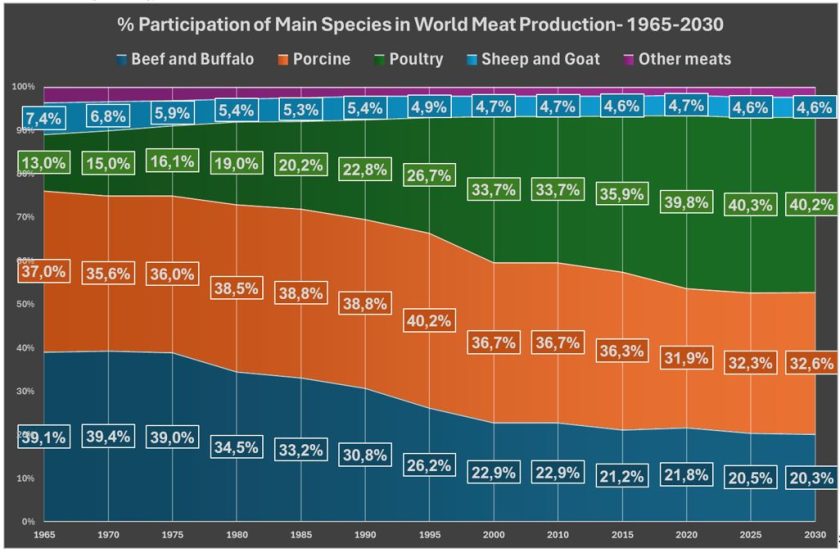
WHAT IS THE REASON FOR THE DECLINE IN BEEF PRODUCTION?
- The reason for this decrease lies in the progressive scarcity of finite natural resources, mainly arable land and water. These finite resources are disputed to produce specific foods, fuels and animal proteins, the famous “feed, food, fuel & fiber”.
- The bovine species uses 15,977 liters of water per kg of meat1 and takes 18 to 48 months to reach slaughter weight and can hardly compete with the most efficient species, especially poultry (1.4 to 1.6 kg IC, 4,335 liters of water and 36 to 38 days to reach slaughter weight) and aquaculture.
- This then means that beef is doomed to disappear. Obviously not, but outside of countries where you can find livestock in your backyard, beef will become a luxury item.
- In the coming decades, make sure you have a bank guarantee or platinum credit card before ordering an “entrecôte”, “bife de chorizo”, “NY strip”, “filet” or “picanha”. And we will be happy with processed beef products, which are expensive but accessible.
- We must also consider that in the world population there are close to one billion people whose average income allows food to represent less than 20% of the household spending budget. And this “top billion” can afford to eat whatever they want, where price is a minor or non-existent consideration. And in this future, cattle in the field (extensive farming) will only be seen in History Channel documentaries.
The large beef groups would have to extend their action to short-cycle proteins, such as poultry and pork. If they did not do so, their universe of business action would be restricted to a type of progressively limited market.
MOTIVATION TO EXPAND ITS FIELD OF ACTION
I believe that this is one of the motivations for groups with a history of cattle farming and red meat production to expand their activity to include “meat of the future” in the first instance and in a second “animal proteins of the future”, adding poultry and pork, eggs, aquaculture fish and dairy products.
These same groups also shook the market with the acquisition of several companies around the world, in an expansion of surprising speed. There were already Brazilian livestock groups with a tradition of production in other countries, whether in MERCOSUR neighbors or in Australia, but the simultaneity of becoming multispecies and having a presence in the most important world markets surprised the main global players in the animal protein segment.
The main Brazilian poultry and pork groups, with a historic presence in international trade, followed suit by internationalizing their distribution operations in key markets and production in strategic countries.
What is the motivation for this process of globalization of operations? I think this process results from a few factors:
a) human diet migrates towards a greater intake of products of animal origin as income expands, a notable fact especially in Developing Countries.
b) products of animal origin require much more natural resources than products of plant origin and many of these expanding markets in Developing Countries do not have the resources of arable land, favorable climatic conditions, photosynthesis and water.
c) water is the decisive element as products of animal origin require three to four times more water than those of plant origin.
d) In meat exports, Brazil is the main world power, with good prospects.
However, Brazil is an agribusiness power located in a country that does not count internationally, with low power of retaliation and, consequently, of international negotiation.
Given this reality and perspectives, seeking to globalize their operations makes perfect sense for the main Brazilian companies in the meat sector.
- The example of two groups of origin in beef has already been followed by other relevant groups operating in the other meat sector.
HOW CAN A COMPANY BECOME GLOBAL?
The export model is no longer sufficient for a company to intend to have global action and if it does not globalize its actions, it must be satisfied with the condition of an international company, producing in one country and sending its products to countries around the world.
- The sustainability of such a company could give way in the face of protectionism, animal health episodes, infrastructure deficiencies, suffocating fiscal and bureaucratic burdens, manipulated exchange rates, attacks of populism so much to the Latin American recidivist taste, to name a few of the many risks.
A company only becomes global if it is present at least among the main global players. There are 204 countries and territories that appear in the FAOSTAT statistics that I usually use in my studies. Would this then be a herculean task?
Not to the extent that the meat segment is extremely concentrated, it is common for fifteen countries, different according to species, to concentrate ≥75% of production, imports, exports and ≥50% of meat consumption, as we can see in the Table 3.

This does not mean that the company must be present in all 15 countries, but rather that its strategy must include them so that it can produce or process in some of them, import and distribute in others, and have export platforms in those where it is convenient, and build a presence in the main consumer markets.
- I have stated that a global company must necessarily be a local company in the 15 countries that represent >50% of the global total.
The Pareto charts at the end of this article list the 15 main countries in production, exports, imports and consumption of the three meats, which exceed 90% of the world total.
If global companies are not active in these markets, they will become mere international companies, producing here and there to sell there, which weakens their long-term sustainability.
STRATEGY CONSTRUCTION
There is convergence of players in the main species and their segments, which will facilitate the construction of the strategy so that the company’s presence is global.
- For a company to be global, it must become local. It is essential that the global company participates in the reality of each local market in which it operates, in a way that is committed to the variability of each local market, its habits and customs.
- The company’s global action will allow it to dilute the risks and fluctuations of each of the markets in which it operates, making it locally stronger than its competitors and using this same local variability to better compete internationally. The “glocal” company will prevail over the international company and will coexist with its local peers.
There is no longer room for the East or West India Company model, nor for the international model, where I am satisfied based on the competitiveness I enjoy in a certain country to export to countless countries around the world.
Aiming to be global from a single national base is less sustainable than building this globality from the sum of local efficiencies, which is what I advocate for building the “glocal” company model.
EXAMPLES OF GLOCAL COMPANIES
There are several examples of glocal companies, and to stay in the comfort zone I would mention the large glocal grain companies. Brazil is one of the three largest grain producers in the world and if we look at the five largest companies operating in the country in this segment, we will see that none of them are native Brazilians.
- Does this mean that these companies would not be committed and engaged with this segment in Brazil? I think even well-intentioned blind people or people with excellent vision blinded by ideology can see that they are as local as those born here.
The two companies originating from the beef segment, born in Brazil, have operations in Brazil, Argentina, Australia, USA, Uruguay, Paraguay, Chile, Mexico, China, Russia and the European Union, to which are added distribution centers in Egypt, Algeria, Congo, D.R. of Congo, Angola, Taiwan, South Korea and Japan and not to mention commercial offices in dozens of countries. They have become “glocal”.
The third company glocalized by acquiring distribution and manufacturing structures in the Middle East, South America and Eurasia and established production operations in Saudi Arabia, the UAE and Turkey. The latter is a perfect example of the benefits of “glocalization”.
In Turkey’s Poultry Meat Balance (Table 4), they began to place greater emphasis on the export of poultry meat from 2010 onwards, albeit with fluctuations.

Turkey has become, in the period2022-20, the fifth largest exporter of poultry meat in the world and existing projections indicate advances in expression until 2032. On the other hand, One Foods has certainly benefited from its local presence, improving its knowledge about the production of this strategically located country, profiting from its logistic facilities to access some of the main halal markets.

These groups diversify their actions to become glocal food companies, and their local presence provides the global group with technology, solutions, inventiveness, creativity, experience and examples of local success, which are interchangeable and adaptable in favor of the global group. Therein lies the strength of the “glocal” company and “glocality”.
- Local presence can be achieved through the acquisition of existing companies, investments in projects from scratch and joint ventures with local groups.
The existence of these “glocal” groups does not mean that local companies are doomed, as the yin and yang of modern business management imply cooperating and competing, in what in articles and conferences I called “hunting in a pack and defending oneself in a pack”.
Is “glocality” a guarantee of success and survival for “glocal” companies?
I often say that anyone looking for a guarantee should buy a car, or an appliance produced by a glocal group. They are offering guarantees of 3 to 5 years or until the next World Cup, when we hope for the sake of hoping that the Brazilian team returns to knowing how to play football.
There are no guarantees of success in the business world, but there are formulas for minimizing risks and maximizing the chances of survival:
- have a strategy for the next ten years, without neglecting to seek results in the current year.
- understand that the objective of an organization is, above all, to survive.
- knowing that the achievements that brought us to today are no guarantee of success tomorrow. Therefore, permeability to new ideas, new concepts and “I know that I don’t know”.
- nothing replaces efficient administration, decisions based on facts and data, PDCA, motivated and engaged people. And remember that you only manage what you control.
- avoid the Louis XIV Complex.
- innovation, updating and alliances with links in the chain. You can’t fight alone anymore. You must have allies in the trenches.
We could list other success formulas, but work, vision, strategy, control and permeability to ideas should be enough.
And remember that “things change”, which is why quantified scenarios over the next ten years are essential in strategic planning. Grow and glocalize. And glocalize to grow.
I finish with Pareto charts of production, imports, exports and consumption of the three main meats, where the fifteen main countries in each of these segments are recorded.
BEEF MEAT

POULTRY MEAT
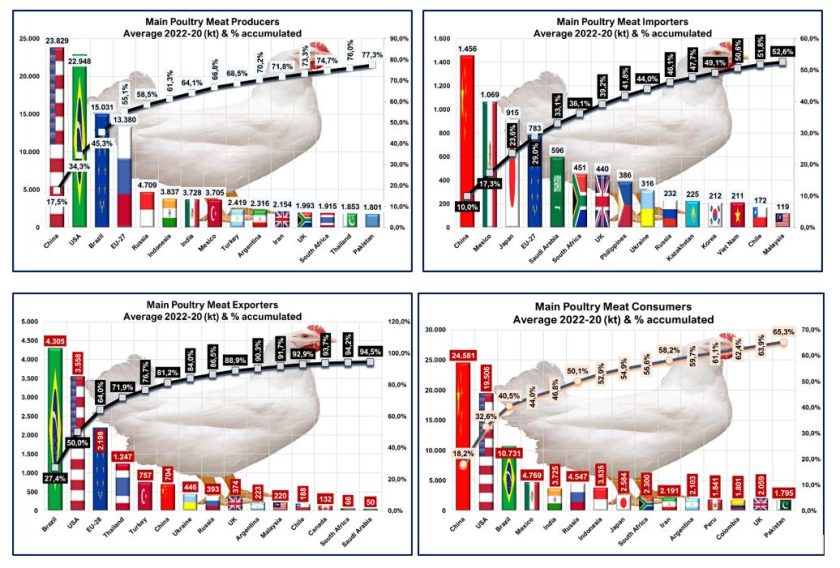
PORK MEAT
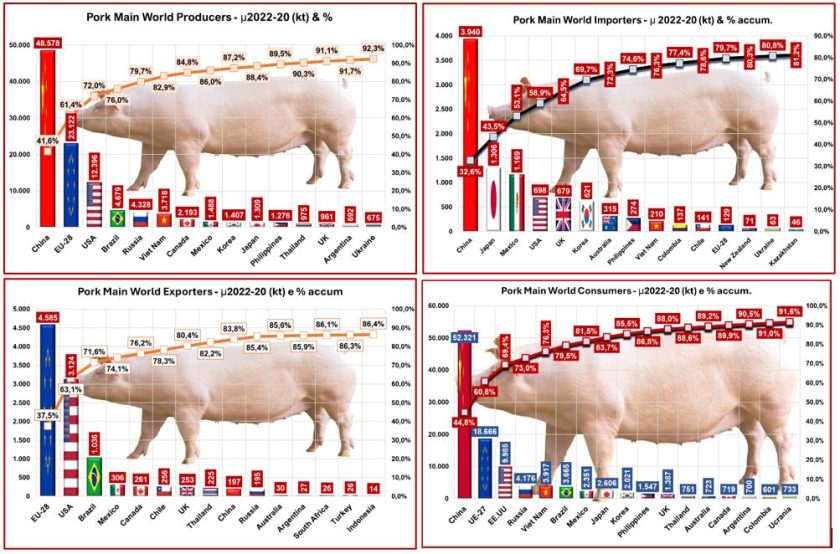
1Source: Prepared by ODConsulting.









